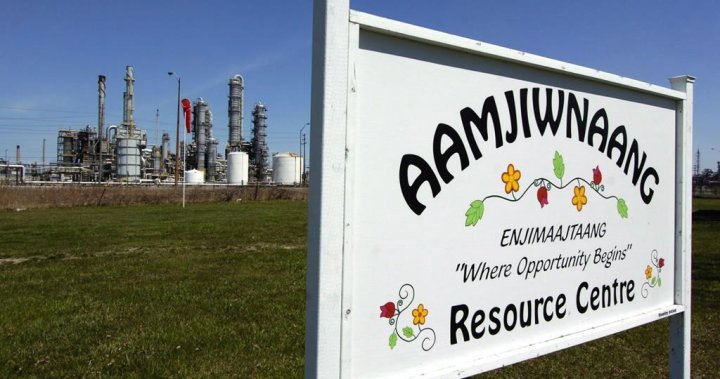The Aamjiwnaang First Nation issued a precautionary evacuation notice for select areas near the INEOS Styrosolution plant due to the removal of benzene, a cancer-causing chemical. The plant was shut down in April after high levels of benzene were detected, leading to illnesses among residents and a state of emergency declaration by the community. The company has announced plans to permanently close the plant by 2026 and was mandated to remove benzene from the site by October 16. The government-mandated removal plan may result in elevated benzene emissions, but they are expected to be localized and not cause adverse effects to the local population.
Several offices of the Aamjiwnaang First Nation, including the band office, were closed in anticipation of the benzene removal, with staff working from home. Benzene exposure can cause neurological symptoms like dizziness and headaches in the short-term, and long-term exposure can lead to cancers like leukemia. Benzene is a clear, mostly colorless liquid found in crude oil and is used to make styrene, a lightweight plastic used in various products. Federal Environment Minister Steven Guilbeault described the evacuation as precautionary and stated that the government would continue to monitor the situation and intervene if necessary.
The federal and provincial governments implemented stricter regulations at the plant earlier in the year following concerns about elevated benzene levels. The Aamjiwnaang First Nation set up monitors in the community to track emissions during the benzene removal process. The company’s announcement to permanently close the plant by 2026 is seen as a positive step in resolving the benzene contamination issue. Despite the expected increase in benzene levels until Saturday, the evacuation notice was issued as a precautionary measure to ensure the safety of residents.
The styrene plant’s closure and the removal of benzene are critical steps in addressing the health and environmental concerns raised by the Aamjiwnaang First Nation and the surrounding community. The government’s involvement in monitoring and regulating the situation demonstrates a commitment to protecting the well-being of residents in the area. The effects of benzene exposure, both short-term and long-term, highlight the importance of addressing chemical contamination promptly and effectively. The Aamjiwnaang First Nation’s proactive approach to issuing an evacuation notice shows a dedication to safeguarding the health of its members and preventing further illnesses linked to benzene exposure.
Overall, the precautionary evacuation notice issued by the Aamjiwnaang First Nation reflects a concerted effort to address the benzene contamination issue and protect the community’s health and well-being. The planned closure of the styrene plant and the removal of benzene are steps towards resolving the concerns raised by residents and addressing the environmental impact of the chemical. Collaborative efforts between the First Nation, government authorities, and the company are essential in ensuring a safe and sustainable resolution to the benzene contamination problem. Moving forward, ongoing monitoring and interventions will be crucial in preventing future incidents and safeguarding the community from harmful chemical exposure.


